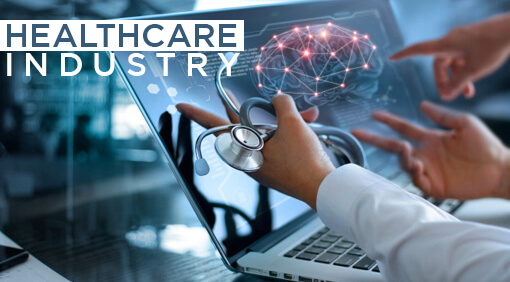The healthcare industry is booming with the involvement of advanced technology interventions. One big aspect of the healthcare industry is laboratory management. Labs are the backbone of medical care, and this modern era demands sheer automation with seamless data availability. To streamline the overall laboratory management, LIMS software comes into play.
LIMS, or Laboratory Information Management System, stands as a crucial pillar in the world of modern scientific research. By serving as a centralized hub for data management, LIMS streamlines laboratory processes and enhances efficiency.
LIMS is a sophisticated software solution that masterfully handles multiple tasks. From tracking samples and managing test results to automating workflows and ensuring regulatory compliance, its prowess knows no bounds.
LIMS is not limited to just one type of laboratory. Its adaptability allows it to cater to various scientific domains, such as pharmaceuticals, biotechnology, environmental testing, and even food and beverage industries.
By providing secure access controls, audit trails, and version control, it safeguards invaluable information from potential mishaps. Moreover, it empowers scientists to make data-driven decisions with confidence. On this note, let’s look at some of the LIMS statistics.
LIMS Statistics
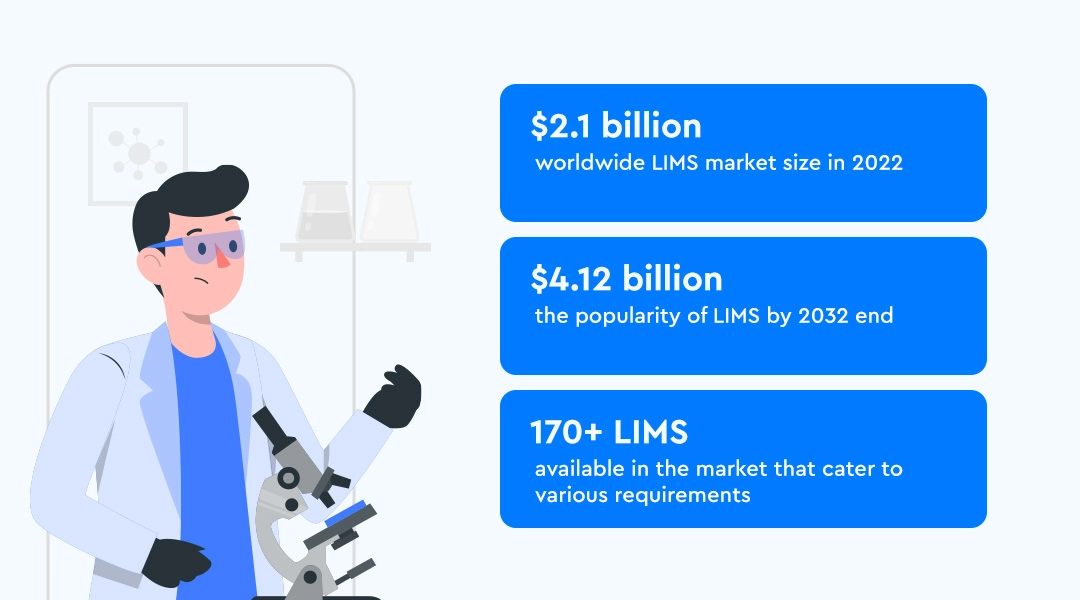
1. According to reports, the worldwide LIMS market size was around $2.1 billion in 2022, and it’s expected to surge at a CAGR of approximately 6.74% between 2024 and 2030.
2. According to the Reports and Data portal, the popularity of LIMS will significantly increase in the upcoming years as it will touch the mark of $4.12 by 2032 end.
3. Currently, there are more than 170 LIMS available in the market that cater to various requirements.
After exploring the statistics, let’s check out why you should build custom LIMS software to add more value to the medical world.
Why build bespoke LIMS software?
Laboratory Information Management Systems (LIMS) are transforming labs’ operations, streamlining processes, and improving efficiency. But why should you invest time and resources into building LIMS software? Here are the top compelling reasons to build a custom LIMS software:
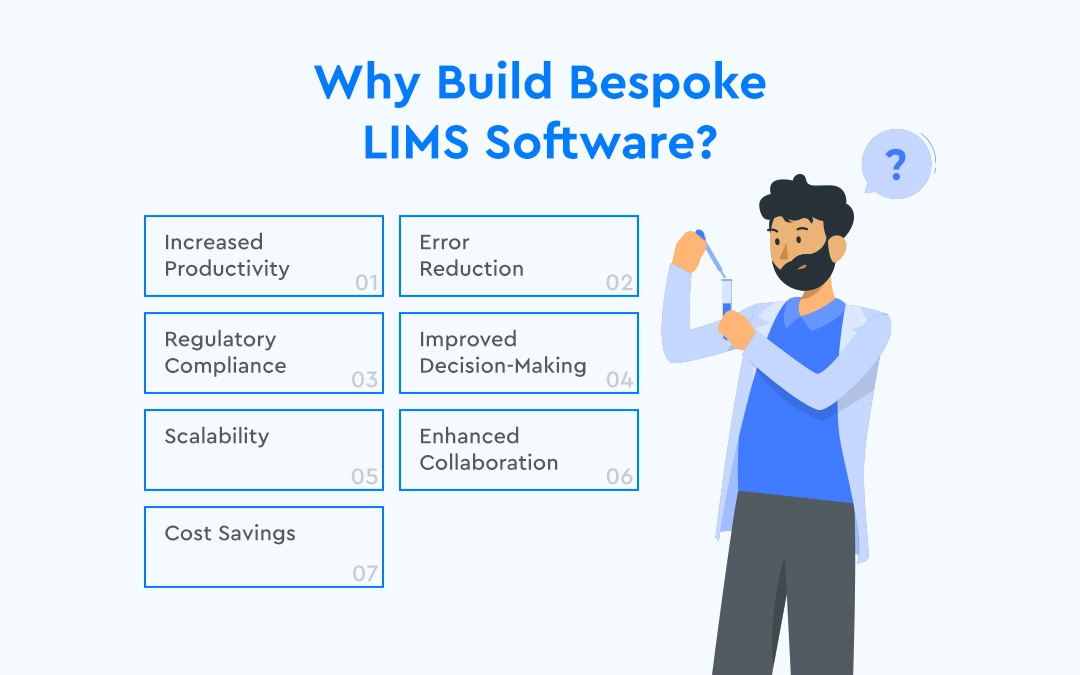
Increased Productivity
With LIMS, manual tasks like data entry, sample tracking, and report generation become automated. This frees up your team’s time, allowing them to focus on what truly matters: scientific discovery. Furthermore, you can easily automate tedious tasks that are prone to human errors and cause work delays if the data is inaccurate.
Error Reduction
Let’s face it — human error is inevitable. However, LIMS can significantly minimize these mistakes by automating data transfer and validation. As these systems work on the combination of different algorithms, the chances of human errors are none. You can easily rely on the accuracy and overall efficiency of your custom LIMS software.
Regulatory Compliance
Struggling with stringent regulations? Fear not! A LIMS software ensures your lab stays compliant by maintaining accurate records, tracking samples, and generating audit trails. Breathe easy. Furthermore, safeguarding sensitive information is crucial in today’s world. With user access controls, encryption, and secure backups, LIMS software offers robust data protection.
Improved Decision-Making
LIMS provides real-time data and analytics, empowering your team to make informed decisions quickly. Say goodbye to guesswork and hello to data-driven insights. Accurate decision-making becomes more crucial while operating at a scale, and a bespoke LIMS helps streamline the challenges.
Scalability
LIMS software can grow with your lab. As your needs evolve, so does the system—easily adapting to accommodate new workflows, instruments, or users. In addition, a LIMS consolidates all your lab data in one place, making it easily accessible and searchable. The centralized cloud architecture ensures all data is safe, accessible, and readily available to all associated parties.
Enhanced Collaboration
LIMS fosters collaboration among team members by providing a centralized platform, enabling them to share data, results, and ideas seamlessly. Whether multiple laboratories want to collaborate over data sharing or doctors and other professionals need to collaborate, a LIMS makes it possible.
Cost Savings
While building a LIMS may require an initial investment, the long-term benefits—improved efficiency, reduced errors, and streamlined processes—translate into significant cost savings. Furthermore, when numerous complex things are automated, it helps organizations save more capital.
After exploring the benefits of building a custom LIMS, let’s explore how this system works so that you have a better understanding. Before you dive into LIMS software development, have a brief overview of its working.
How Does a Lab Information Management Software Work?
LIMS is a powerful tool that streamlines workflows, ensuring accuracy and efficiency in the laboratory, but how does it work? Let’s delve into the nitty-gritty of LIMS and explore the steps involved:
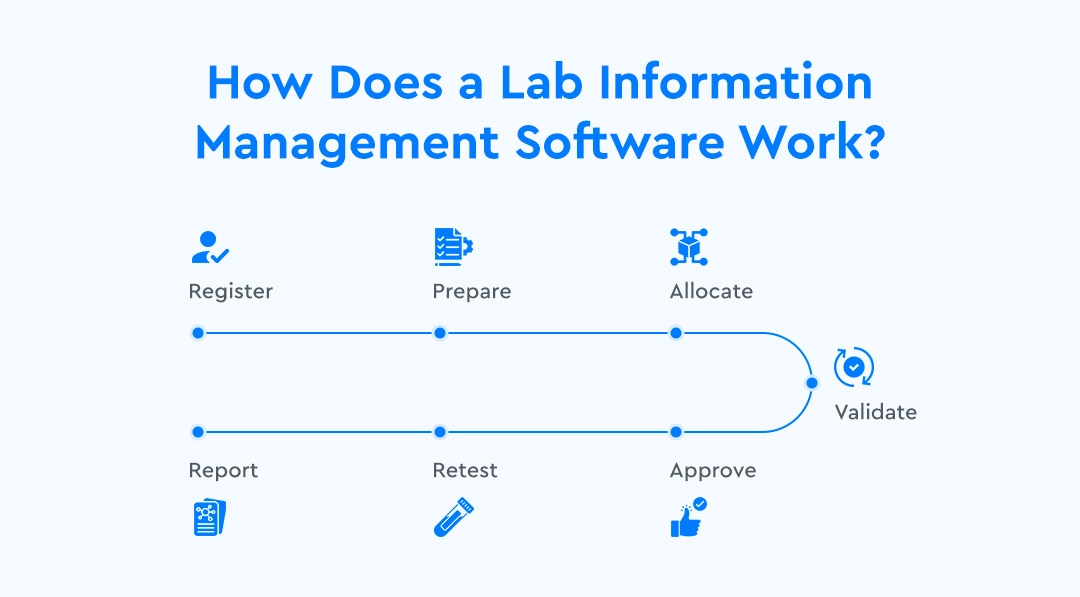
Register
The journey begins with registration. Samples arrive at the lab, each with unique requirements and specifications. LIMS takes charge by logging essential details, such as sample ID, client information, and analysis type. This step paves the way for a smooth, organized workflow that minimizes human error.
Prepare
Next up is sample preparation, and here, LIMS truly shines by offering tailored protocols for each sample type. In this crucial phase, lab technicians follow detailed instructions provided by the software, ensuring consistency and precision. Say goodbye to haphazard practices and hello to streamlined methodologies!
Allocate
Now, it’s time to allocate resources, and using a LIMS, you can assign tasks to appropriate personnel, taking into account their qualifications and workload. This intelligent distribution optimizes productivity while maintaining high-quality standards. Moreover, with LIMS at the helm, supervisors can effortlessly monitor progress, making adjustments as needed.
Validate
Accuracy is paramount in the lab, and no healthcare institution can overlook this fact. Hence, LIMS incorporates validation measures that scrutinize data for inconsistencies. By comparing results against predefined parameters, discrepancies are swiftly flagged, and corrective actions are initiated. With LIMS on the case, you can trust the integrity of your data.
Approve
Once validation is complete, the approval process commences. Senior staff members review and sign off on the results, attesting to their accuracy and reliability. LIMS streamlines this step by automating notifications and providing easy access to relevant data. As the overall test approval process becomes easy to conduct, it removes the chances of human error for accurate results.
Retest
Occasionally, samples may require retesting due to unexpected results or procedural errors. Fear not, for LIMS is well-equipped to handle such scenarios. The software swiftly identifies the need for retesting, alerting staff, and providing instructions for corrective measures. With LIMS in your corner, you can rest assured that no stone is left unturned.
Report
LIMS consolidates data into comprehensive reports tailored to meet client needs. From graphs and charts to written summaries, the software presents information in a clear, concise manner. Moreover, LIMS ensures secure data storage and swift report generation, making it an indispensable tool for any laboratory.
After exploring how these laboratory information management systems work, it’s time to explore which industries should use them.
Which Industries Need Laboratory Information Management Systems?
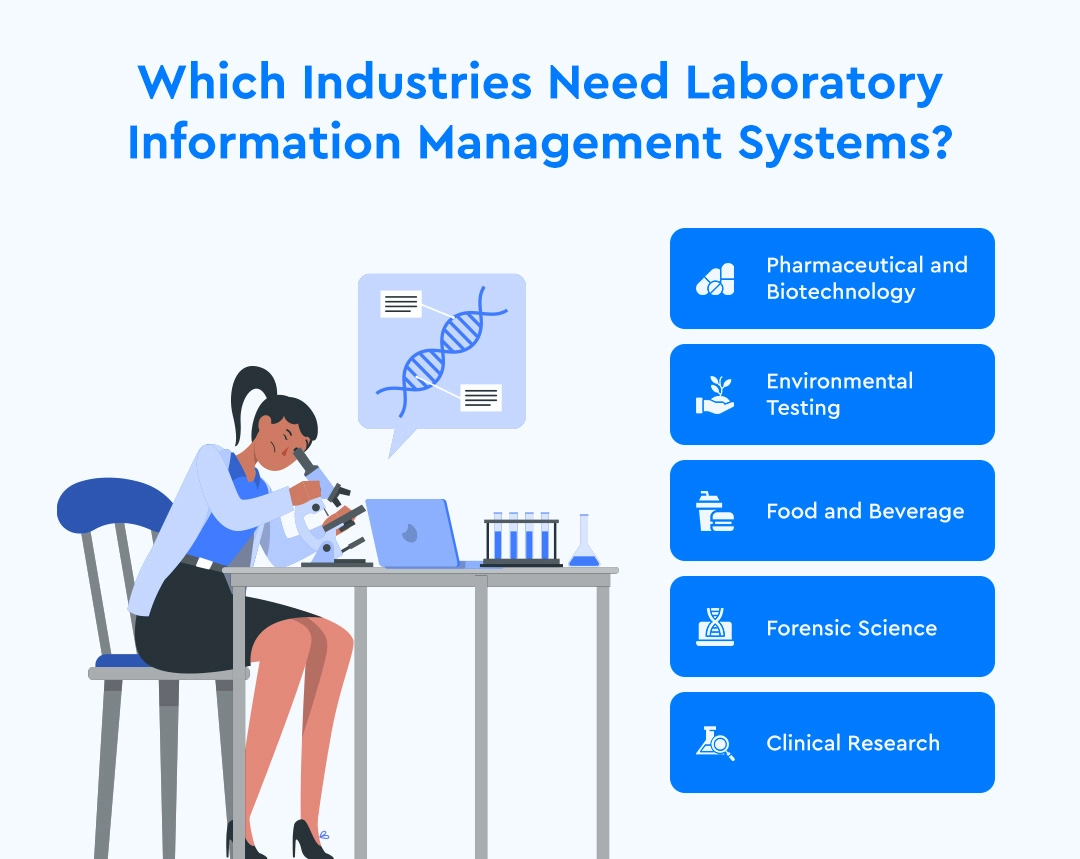
Pharmaceutical And Biotechnology
In an industry where meticulous research and strict regulatory compliance are essential, a LIMS is indispensable. Pharmaceutical and biotech companies rely on these systems for quality control, sample tracking, and data analysis. With LIMS, these organizations can mitigate risks, accelerate drug discovery, and maintain high standards of safety and efficacy.
Environmental Testing
Monitoring our environment is paramount. From water and air quality testing to soil analysis, laboratories in this field must process large volumes of samples daily. A LIMS enables environmental labs to manage complex workflows, automate data entry, and ensure regulatory compliance with ease. Moreover, it helps them generate accurate reports, contributing to better decision-making in environmental conservation efforts.
Food And Beverage
The food industry demands rigorous quality control and safety measures. LIMS plays a vital role in managing data related to ingredient testing, allergen detection, and shelf life analysis. By implementing a LIMS, food, and beverage companies can track samples, maintain traceability, and adhere to stringent regulations. Ultimately, this ensures the production of safe and high-quality products.
Forensic Science
Solving crimes hinges on accurate data collection and analysis. Forensic laboratories benefit from a LIMS’s ability to track and manage evidence, such as DNA samples, fingerprints, and toxicology reports. Additionally, a LIMS enhances collaboration among forensic experts, ensuring secure data sharing and maintaining the integrity of sensitive information.
Clinical Research
Clinical trials generate vast amounts of data that require careful management. A LIMS can streamline clinical research workflows, from patient enrollment to data analysis and reporting. This not only boosts efficiency but also guarantees the accuracy and reliability of trial results. With custom LIMS software development, clinical research organizations can make informed decisions and expedite the development of life-saving treatments.
On this note, let’s look at some of the must-have features of LIMS software so that you can figure out which one to add.
Core features of LIMS software:
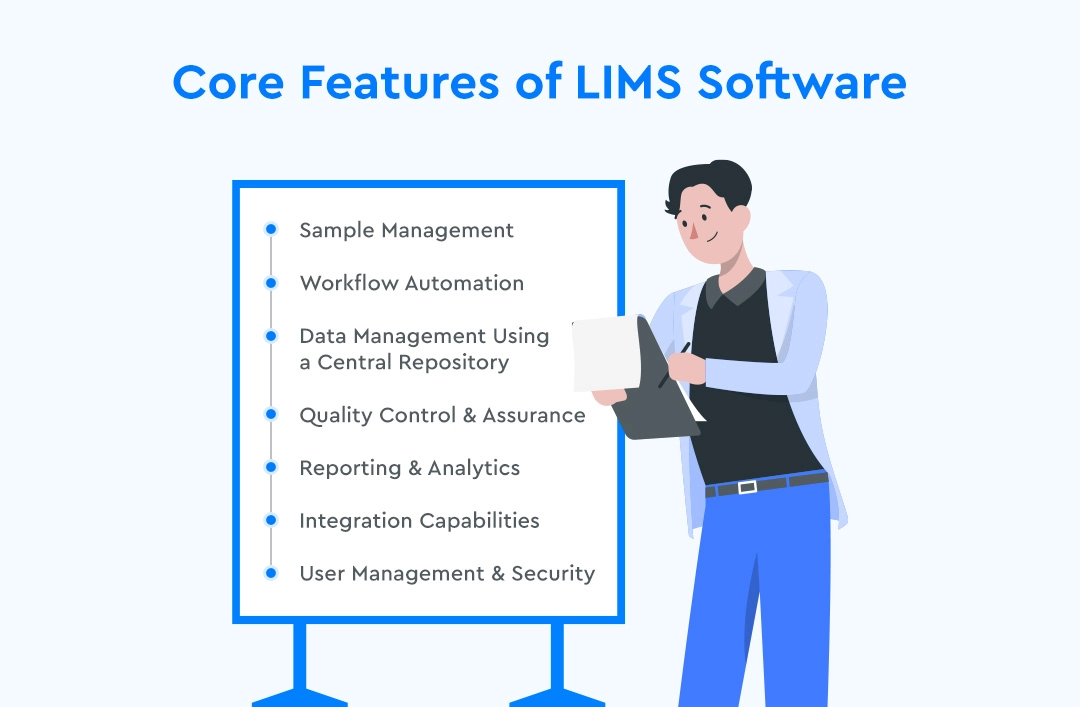
Sample Management
A key aspect of LIMS software is its ability to manage samples effectively. From sample tracking and registration to storage and disposal, a LIMS simplifies the entire lifecycle. The result? Enhanced traceability, reduced errors, and data integrity.
Workflow Automation
Overwhelmed by repetitive tasks? LIMS software automates processes, freeing up valuable time for your team to focus on more crucial work. With customizable workflows, you can tailor the system to your lab’s unique needs, making it an indispensable tool for boosting productivity.
Data Management Using A Central Repository
Imagine having all your laboratory data stored in one place, easily accessible and secure. That’s precisely what a LIMS does. It consolidates data from various instruments, ensuring consistency, accuracy, and compliance with regulatory standards.
Quality Control & Assurance
A LIMS software not only manages data but also ensures the quality of results. Monitoring and controlling critical parameters maintains consistency and helps identify deviations early. Trust in your data is paramount, and a LIMS delivers on that front.
Reporting & Analytics
LIMS software comes equipped with powerful reporting and analytics features, enabling you to visualize trends, identify bottlenecks, and make data-driven decisions.
Integration Capabilities
A LIMS doesn’t operate in isolation as it is capable of integrating with multiple other important software like EHRs. It’s designed to integrate with other laboratory systems and instruments, creating a seamless ecosystem that enhances data flow and reduces manual intervention. Integration results in improved efficiency, accuracy, and collaboration.
User Management & Security
A LIMS prioritizes data security. With features like user management, access control, and audit trails, you can rest assured that your sensitive information remains protected and compliant with regulations.
On this note, let’s look at the costing factor and check out how much it costs to build custom LIMS software for your company.
Cost To Build LIMS Software
The cost of custom healthcare LIMS software development can vary based on multiple factors. These features include complex features, third-party integrations, UI/UX, personalization, and scalability. Although it’s difficult to pin down a precise figure, the cost of building such robust software can range anywhere from $15,000 to $150,000 or more.
In addition, the need for ongoing support, maintenance, and regular updates adds to the overall expenditure. After knowing the approximate budget, check out different factors that affect the overall LIMS pricing.
Factors Affecting The Cost Of Building LIMS Software
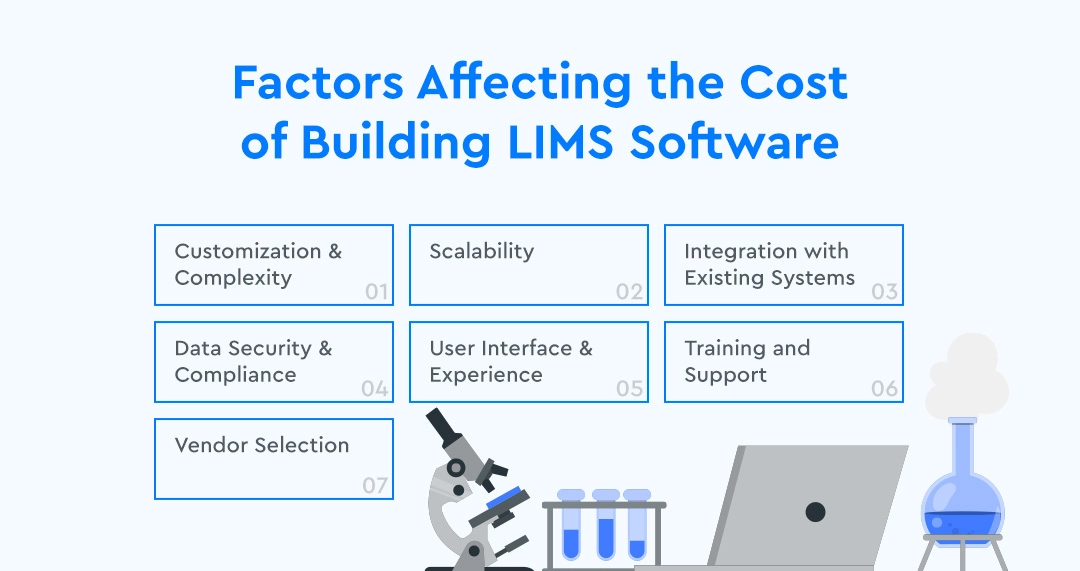
Customization And Complexity
LIMS software can range from simple, off-the-shelf solutions to highly customized systems tailored to specific laboratory needs. The more customization and complexity involved, the higher the development cost. This can include the integration of unique workflows, data management requirements, and automation features.
Scalability
As laboratories grow and evolve, so too must their LIMS software. When designing a system, it’s essential to consider scalability, which can impact the initial price tag. Building a scalable solution from the outset will save time and resources in the long run, even if it means a higher up-front cost.
Integration With Existing Systems
Chances are, your laboratory already utilizes various software and hardware components. Integrating your LIMS with these existing systems can be a significant factor in development costs. This may involve adapting the software to work seamlessly with instruments, databases, and other applications, requiring additional time and expertise.
Data Security And Compliance
Laboratories deal with sensitive information, making data security a top priority. Ensuring that your LIMS software meets industry standards and regulatory requirements (such as GDPR, HIPAA, or GxP) can add to the development cost. This includes implementing encryption, access controls, and audit trails, among other security measures.
User Interface And Experience
A well-designed user interface (UI) and a positive user experience (UX) are crucial for efficient laboratory operations. Investing in LIMS software with an intuitive UI and UX can minimize errors and improve productivity. However, crafting a user-friendly system may necessitate more extensive design and development efforts, influencing the overall cost.
Training And Support
Implementing a new LIMS software requires training for laboratory staff. This can be an additional expense, depending on the complexity of the system and the level of training required. Additionally, ongoing support and maintenance should be factored into the total cost, as software updates and troubleshooting may be necessary over time.
Vendor Selection
Choosing a development to develop your LIMS software can also impact the cost. Different companies may offer varying levels of expertise, services, and pricing structures. It’s essential to carefully evaluate potential vendors carefully, considering not only their initial quotes but also their track record, responsiveness, and ability to meet your specific needs.
Thus, it’s important to hire a professional company like AGS for healthcare LIMS software development. With the help of an experienced company, you can save development costs by choosing the right technology stack, development methodology, and more.
Why Hire Auxano Global Services For LIMS Software Development Services?
Auxano Global Services, a top player in software development, offers exceptional healthcare software development services. Our skilled team has a deep knowledge of lab workflows and excels at creating customized software that simplifies tasks. At Auxano, you’ll witness a perfect combination of advanced tech and industry know-how, resulting in powerful LIMS software to boost your lab’s effectiveness.

With Auxano, you can count on a flexible, quick-to-adapt approach that keeps your LIMS software ahead of the game. We are dedicated to spotting and tackling potential issues early on, ensuring your system remains versatile and future-ready. In an ever-changing technological landscape, Auxano Global Services offers the latest technology stack and relevant experience to get you going.
Wrapping Up!
LIMS is a robust, reliable solution for laboratories of any size. However, the costs associated with building a custom software system are often significant and require careful consideration. Factors such as integration with existing systems, data security and compliance, user interface and experience, training and support, and vendor selection can influence the development cost. Working with a professional company like AGS can help you save costs while also ensuring a great experience.
Frequently Asked Questions
-
1. What Is LIMS Software, And Why Is It Essential For Laboratories?
LIMS (Laboratory Information Management System) software helps labs manage data, workflow, and resources more effectively. It streamlines tasks, boosts productivity, and ensures sample tracking, testing, and reporting accuracy.
-
2. How Does Custom LIMS Software Development Benefit My Laboratory?
Custom LIMS software is tailored to your lab’s specific needs and processes. This bespoke approach results in a system that fits seamlessly into your operations, enhancing efficiency and enabling growth without compromising functionality.
-
3. What Factors Should I Consider When Choosing A LIMS Software Development Partner?
Look for a partner with a proven track record, industry knowledge, and technical expertise. They should understand your lab’s unique requirements and be able to create a solution that evolves with changing needs and technology advancements.
-
4. Can LIMS Software Integrate With Existing Systems In My Laboratory?
A well-designed LIMS solution can integrate with your current systems, like electronic lab notebooks or instruments. This ensures smooth data flow, reduces redundancy, and promotes seamless tool collaboration.
-
5. How Does LIMS Software Ensure Data Security And Regulatory Compliance?
LIMS software often includes robust security measures like encryption and access controls. Additionally, it can be designed to meet specific regulatory standards, helping your laboratory maintain compliance while safeguarding sensitive information.



